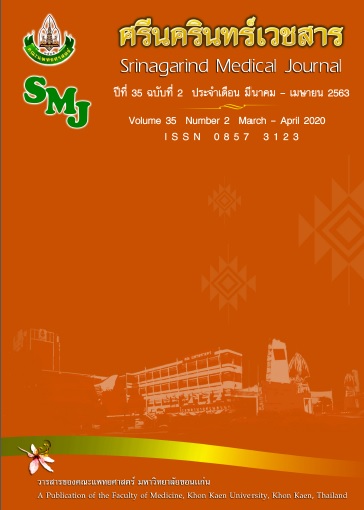Outcome of Anaphylaxis Protocol at Emergency Department, Srinagarind Hospital
Keywords:
Anaphylaxis; Anaphylaxis protocol; Emergency departmentAbstract
Background and objective: Anaphylaxis is a serious condition. Under diagnosis or under treatment could lead to mortality. Srinagarind hospital has published protocol for anaphylaxis to improve the quality of treatment. The objective of this study was to determine percentage of patients who get adrenaline injection, route of adrenaline injection, time of adrenaline injection and emergency department length of stay after the anaphylaxis protocol used.
Methods: This was a retrospective descriptive study, with medical record review was conducted. All patients came to emergency room at Srinagarind hospital during January 1st, 2014 and December 31st, 2015 who met criteria for diagnosis of anaphylaxis were included.
Results: From 136,266 visitors, the number of researched patients was 174 which was found with using the protocol for anaphylaxis in 99 cases (56.9%) and without using it in 75 cases (43.1%). All patients in each group (100%) were injected with adrenaline. Route of adrenaline injection was intramuscular injection (100%) The median of time of patients injected adrenaline were 12.5 and 15 minutes and the median of emergency department length of stay time were 53 and 69 minutes in group of the protocol for anaphylaxis usage and unusage, respectively.
Conclusions: After the protocol for anaphylaxis was established, all patients got adrenaline injection by using intramuscular injection as standard treatment. There were no statistical significant difference in time to receive adrenaline and emergency department length of stay when compared the protocol for anaphylaxis usage group with the protocol unusage group.
References
2. Simons FER, Ardusso LRF, Dimov V, Ebisawa M, El-Gamal YM, Lockey RF, et al. World Allergy Organization Anaphylaxis Guidelines: 2013 update of the evidence base. Int Arch Allergy Immunol 2013; 162: 193–204.
3. Ma L, Danoff TM, Borish L. Case fatality and population mortality associated with anaphylaxis in the United States. J Allergy Clin Immunol 2014; 133: 1075–83.
4. Simons FER, Ardusso LRF, Bilò MB, El-Gamal YM, Ledford DK, Ring J, et al. World allergy organization guidelines for the assessment and management of anaphylaxis. World Allergy Organ J 2011; 4: 13–37.
5. Simons FER, Ebisawa M, Sanchez-Borges M, Thong BY, Worm M, Tanno LK, et al. 2015 update of the evidence base: World Allergy Organization anaphylaxis guidelines. World Allergy Organ J [Internet]. 2015 Oct 28 [cited Mar 2, 2016]; 8(1). Available from: http://www.ncbi.nlm.nih.gov/pmc/articles/PMC4625730/
6. Phreawa Thatphet, Kamonwon Ienghong, Dhanu Gaysonsiri, Korakot Apiratwarakul, Wutchara Ruttanaseeha. Anaphylaxis in Emergency room Srinagarind Hospital : A 5-Years Retrospective Study. Srinagarind Med J 2017; 32: 534-41.
7. Clark S, Camargo CA. Emergency management of food allergy: systems perspective. Curr Opin Allergy Clin Immunol 2005; 5: 293–8.
8. Sampson HA, Muñoz-Furlong A, Campbell RL, Adkinson NF, Bock SA, Branum A, et al. Second symposium on the definition and management of anaphylaxis: summary report--second National Institute of Allergy and Infectious Disease/Food Allergy and Anaphylaxis Network symposium. Ann Emerg Med 2006; 47: 373–80.
9. Poachanukoon O, Paopairochanakorn C. Incidence of anaphylaxis in the emergency department: a 1-year study in a university hospital. Asian Pac J Allergy Immunol Launched Allergy Immunol Soc Thail 2006; 24(2–3): 111–6.
10. Manivannan V, Hess EP, Bellamkonda VR, Nestler DM, Bellolio MF, Hagan JB, et al. A multifaceted intervention for patients with anaphylaxis increases epinephrine use in adult emergency department. J Allergy Clin Immunol Pract 2014; 2: 294–9.
11. Arroabarren E, Lasa EM, Olaciregui I, Sarasqueta C, Muñoz JA, Pérez-Yarza EG. Improving anaphylaxis management in a pediatric emergency department. Pediatr Allergy Immunol Off Publ Eur Soc Pediatr Allergy Immunol 2011; 22: 708–14.
12. Smit DV, Cameron PA, Rainer TH. Anaphylaxis presentations to an emergency department in Hong Kong: Incidence and predictors of biphasic reactions. J Emerg Med 2005; 28: 381–8.
13. Piromrat K, Chinratanapisit S, Trathong S. Anaphylaxis in an emergency department: a 2-year study in a tertiary-care hospital. Asian Pac J Allergy Immunol Launched Allergy Immunol Soc Thail 2008; 26(2–3): 121–8.
14. Pluemchitmongkhon P. Clinical manifestations of Anaphylaxis at the Emergency Department. Khon Kaen Med J 2011; 35: 36–43.




